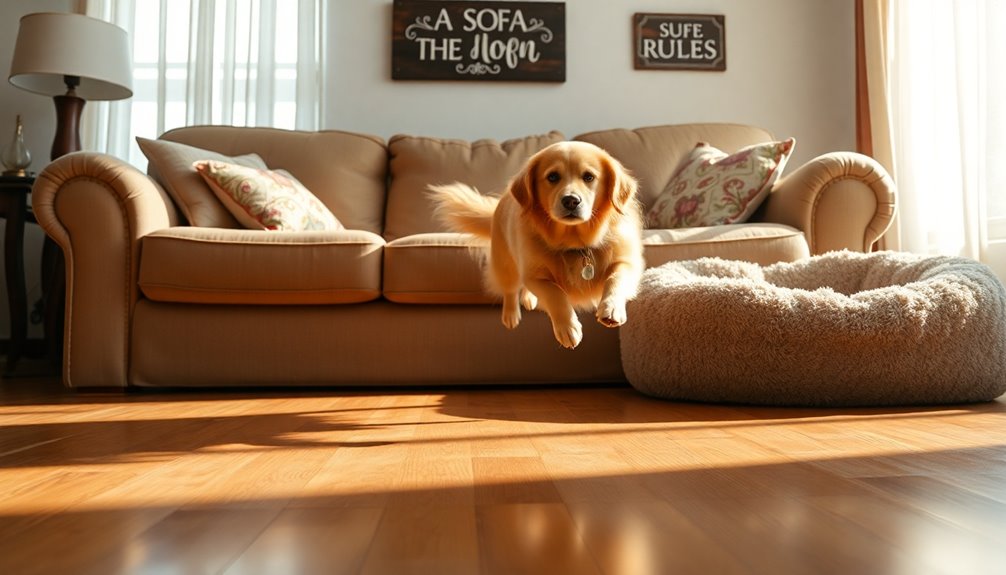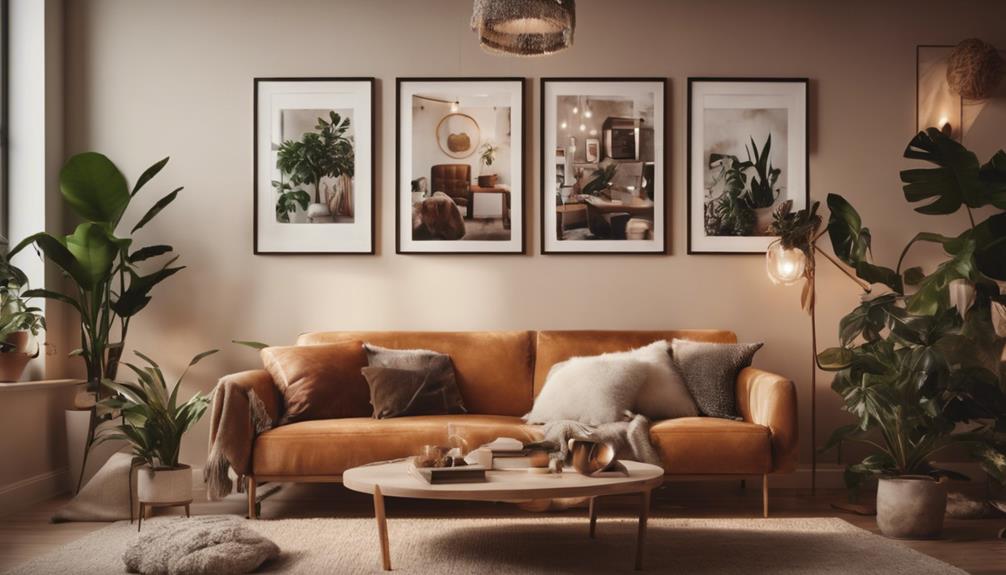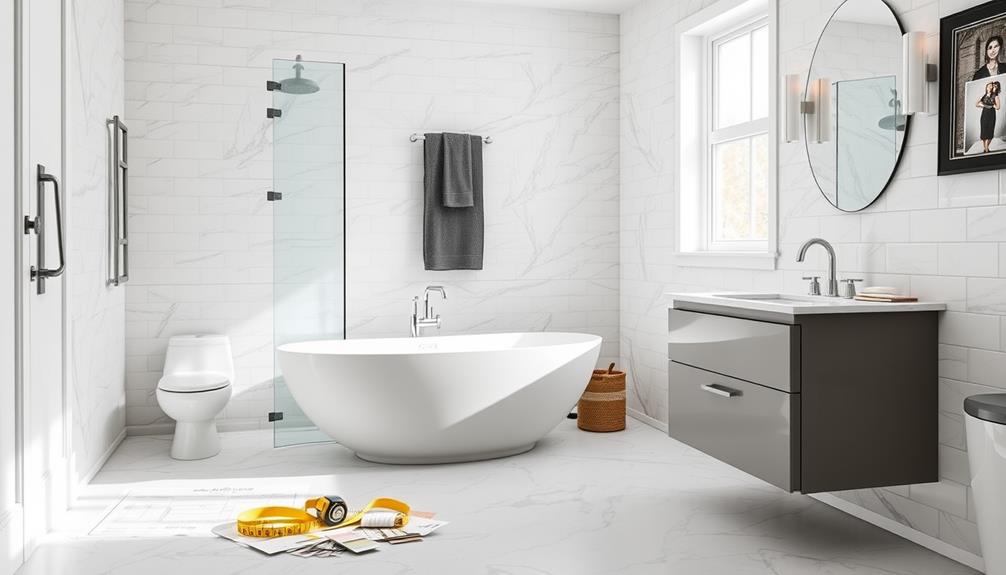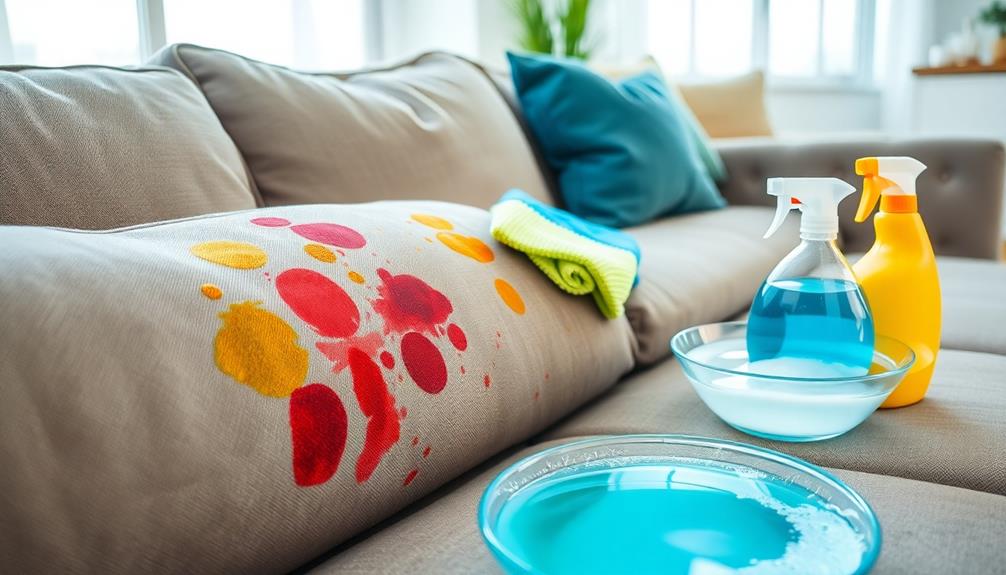To keep your dog off the sofa, start by using consistent training methods. Teach commands like "off" or "stay" to reinforce boundaries. You can also use physical barriers like couch defenders or baby gates to create clear limits. Consider adding textured slipcovers or double-sided tape to make the sofa less inviting for your pup. Additionally, engaging with your dog on the floor and offering a cozy bed nearby provides an alternative resting place. By combining training with protective strategies, you'll establish a dog-free zone on your couch. Discover more tips to enhance your pet-proofing approach!
Key Takeaways
- Use consistent training commands like "off" and "stay" to establish rules about furniture access for your dog.
- Implement physical barriers like Couch Defenders or baby gates to restrict your dog's access to the sofa.
- Engage with your dog on the floor to reduce the desire to jump on the couch.
- Regularly remove enticing items from the sofa to make it less appealing to your dog.
- Apply textured materials or double-sided tape on furniture to deter your dog from jumping up.
Introduction
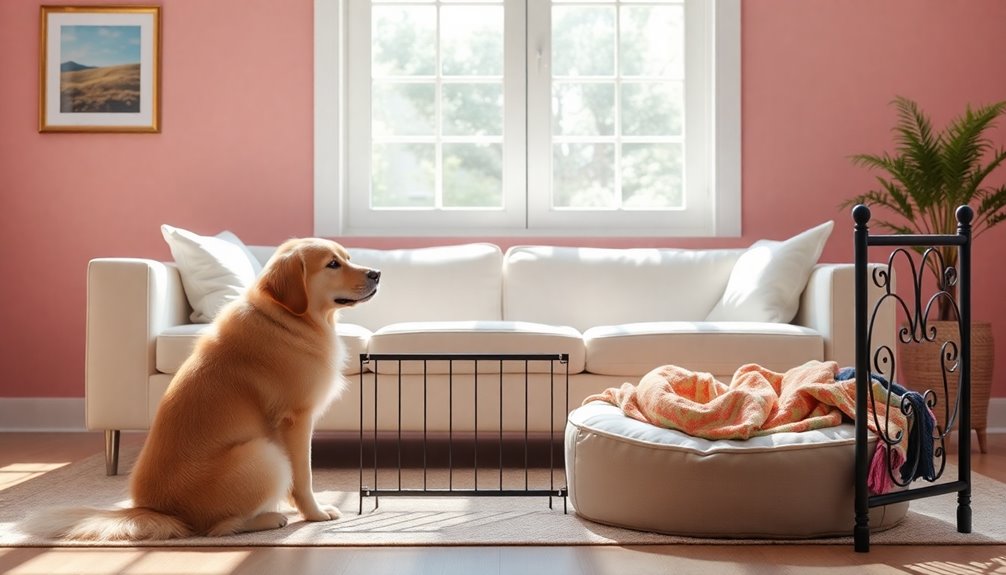
Keeping your dog off the sofa is just part of maintaining a clean home. You'll need to focus on routine vacuuming and spot cleaning to manage pet hair and odors effectively. Additionally, using fabric-specific cleaning techniques will help you tackle any messes without damaging your furniture.
Routine Vacuuming and Spot Cleaning
Vacuuming regularly and spot cleaning any messes are essential steps in maintaining a pet-friendly home. Routine vacuuming helps remove dog hair and dander from your sofa, which reduces allergens and keeps your living space cleaner. It's best to set a cleaning schedule, like weekly vacuuming, to ensure your home stays fresh and discourages your dog from jumping back on the couch.
When it comes to spot cleaning, act quickly after any spills or accidents. Using pet-safe cleaners immediately can prevent stains and odors from setting in, extending the life of your furniture. A vacuum with a pet hair attachment or a lint roller can effectively capture hair from tight spaces and fabric surfaces, ensuring a thorough clean.
Consider using machine-washable couch covers to simplify maintenance. They protect against dirt and dog hair while allowing for easy washing. By combining routine vacuuming with prompt spot cleaning, you'll create a cleaner environment that feels more inviting for you and less welcoming for your furry friend. This approach not only keeps your sofa in better condition but also reinforces the idea that the couch isn't a place for your dog.
Fabric-Specific Cleaning Techniques
Different types of fabric on your sofa require unique cleaning techniques to maintain their appearance and longevity. For instance, if you have a microfiber sofa, you can easily clean it with a damp cloth and mild soap. On the other hand, leather needs special care; using a conditioner will prevent cracking and keep it looking fresh. Always check the manufacturer's care label to avoid damaging your sofa.
If you're dealing with pet hair, a lint roller or rubber gloves works wonders for removing it without leaving behind residue. For stubborn stains, a mixture of white vinegar and water can be an effective natural solution, but remember to test it in an inconspicuous area first.
Regular maintenance is key. Vacuuming your sofa frequently and applying fabric protectors can help prevent stains and prolong the life of the fabric. Additionally, consider investing in dog beds to give your furry friend a cozy spot of their own, which may keep them off your sofa altogether. By following these fabric-specific cleaning techniques, you'll ensure your sofa remains in top shape despite the challenges of pet ownership.
Eliminating Pet Urine Smell
Dealing with pet urine smell can be one of the most challenging aspects of pet ownership. When your dog has an accident, the distinct odor caused by ammonia and other compounds can linger in fabrics and upholstery if you don't act quickly. Immediate cleaning is crucial; the longer the urine sits, the harder it becomes to eliminate the smell and prevent staining.
Using enzymatic cleaners is your best bet for effective urine removal. These products break down the components of the urine, eliminating the odor rather than just masking it. After you've cleaned the area, sprinkle baking soda on it to absorb any remaining odors. Vacuum it up after a few hours to help eliminate lingering smells.
Once the area dries completely, test for any residual odor by sniffing it. If the smell persists, you may need to repeat the cleaning process. Keeping dogs off the sofa is easier when you tackle the smell head-on, ensuring your home remains fresh and inviting. With proper cleaning techniques, you can enjoy your pet's company without worrying about unpleasant odors. Additionally, regular grooming can significantly reduce the amount of hair and dander in your home, further enhancing the freshness of your living space.
Sofa Shielding Techniques
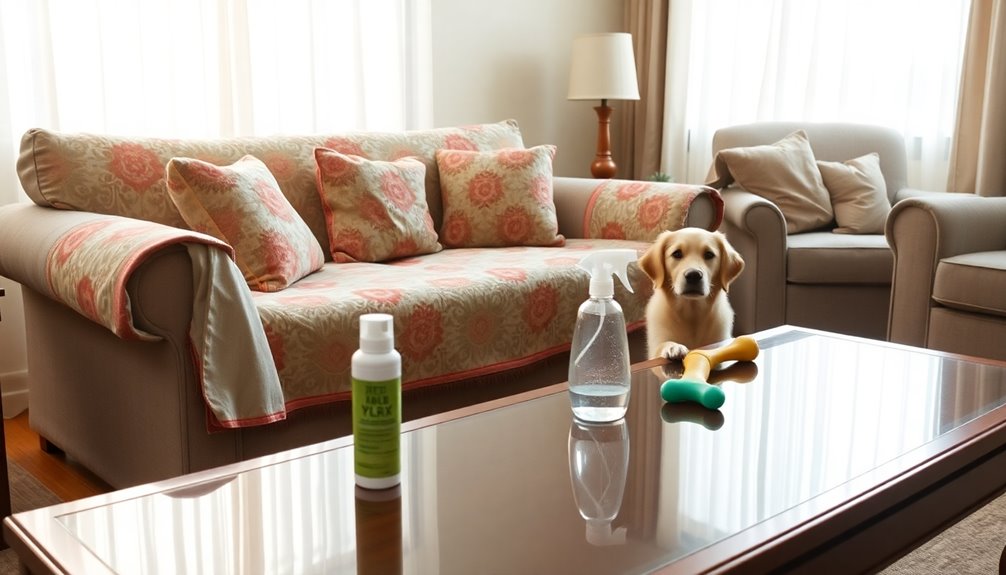
To keep your sofa safe from your dog's claws and fur, consider using scratch-resistant fabrics that can withstand wear and tear. You might also want to layer soft, washable fabrics, making it easy to clean up any messes. Durable slipcovers can provide an extra line of defense, ensuring your furniture stays looking great even with a furry friend around.
Using Scratch-Resistant Fabrics
Using scratch-resistant fabrics is a smart way to keep your dog off the sofa while maintaining the overall look of your living space. Fabrics like microfiber and leather aren't just stylish; they're also less appealing for scratching and clawing, making it harder for your pup to see the sofa as a comfy spot. To further deter your dog, consider applying a protective treatment that repels dirt and stains, creating an uninviting environment.
You might also want to invest in furniture covers or slipcovers made from durable, scratch-resistant materials. These can be easily removed and washed, providing an additional barrier against dog access. For a quick fix, using double-sided tape or furniture protectors can create an unpleasant texture on the sofa, discouraging your dog from jumping up.
Incorporating a couch defender or similar product can physically block dogs from accessing the sofa. This not only aids in dog training but also preserves your furniture. By making these changes, you can effectively keep dogs off furniture while ensuring your living area remains stylish and functional.
Soft, Washable Fabric Layers
Incorporating soft, washable fabric layers like slipcovers and throws offers an effective way to shield your sofa from dog hair and dirt while discouraging your dog from jumping up. Look for slipcovers that fit snugly; this reduces the chance of your dog dislodging them when attempting to access the couch. Opt for layered fabric shields that you can easily remove and wash, allowing for quick clean-up without damaging your furniture.
Consider using textured materials that dogs might find unappealing, such as slick or crinkly fabrics. These can act as a barrier, making the sofa less inviting. Regularly rotating and washing these soft, washable fabric layers not only keeps your sofa clean but also reinforces the idea that it's not a designated resting place for your furry friend.
Using Durable Slipcovers
Durable slipcovers are a game changer for pet owners looking to protect their sofas from wear and tear. Made from heavy-duty polyester or canvas, these slipcovers effectively shield your furniture from dog hair, scratches, and stains while giving it a refreshed look. When choosing slipcovers, opt for those with non-slip backing to keep them securely in place, even when your dog jumps on or off the couch.
One of the best features of durable slipcovers is that they're machine-washable, making it easy to maintain a fresh living environment. Regular washing helps eliminate pet odors and fur, so you can enjoy your space without worry. Look for slipcovers designed with elastic corners or straps for a snug fit—this minimizes the temptation for your dog to dig or scratch at the furniture.
You can also enhance your home's aesthetic with decorative slipcovers in appealing colors or patterns. Not only do they protect your sofa, but they also serve to discourage your dog from accessing the furniture. By incorporating durable slipcovers, you're investing in both protection and style for your living room.
Upholstery Stitching Reinforcement

When reinforcing upholstery stitching, you need to consider both frame stability and the quality of materials used. High-quality leather conditioning treatments can also play a crucial role in protecting your furniture, while cushioned, supportive fabric layers provide comfort and durability. By focusing on these elements, you can better safeguard your sofa from your dog's playful antics.
Frame Stability Concerns
A well-stitched sofa can withstand the enthusiastic jumps of your furry friend, making upholstery stitching reinforcement essential for dog owners. When your dog leaps on and off the sofa, it places stress on the seams and fabric, which can lead to wear and tear. That's why investing in high-quality stitching techniques, like double stitching or heavy-duty thread, is crucial for ensuring frame stability.
Reinforced stitching not only enhances durability but also prevents fraying and tearing, extending the lifespan of your upholstery. This is especially important for dog owners who face the risk of damage. Proper reinforcement techniques can handle the weight and movement of dogs, reducing the likelihood of structural failure in both the sofa's frame and upholstery.
Regular inspections of your sofa's stitching can help you catch early signs of wear, allowing for timely repairs. By maintaining your upholstery, you can uphold the overall stability of your furniture in a pet-friendly home. So, pay attention to those seams and choose upholstery options that can stand up to your dog's playful nature, ensuring both comfort and longevity in your living space.
Leather Conditioning Treatments
Regular leather conditioning treatments are essential for keeping your upholstery in top shape, especially if you have pets. These treatments maintain the suppleness and durability of your leather, preventing damage from dog claws or accidental scratches. By applying conditioning products, you create a protective barrier that shields your furniture from dirt and moisture, which is particularly beneficial in homes with furry friends.
To ensure optimal results, it's best to condition your leather furniture every 6-12 months, depending on how much wear it sees from your dog. Before applying the conditioning treatment, utilize specialized leather cleaners to remove debris and oils, allowing the treatments to penetrate effectively.
Additionally, reinforcing your upholstery stitching is crucial. Dogs may pull or tug on the fabric, which can lead to tears. Using heavy-duty thread or adding extra stitching can extend the lifespan of your leather furniture, making it more resilient against everyday wear and tear. By combining regular leather conditioning treatments with sturdy stitching, you'll keep your sofa looking great while also protecting it from your beloved pet's playful antics.
Cushioned, Supportive Fabric Layers
Cushioned, supportive fabric layers in upholstery not only enhance comfort but also make your sofa more appealing to dogs. When you invest in a sofa with plush, inviting fabric, you might inadvertently encourage your dog to jump on it for relaxation instead of using their designated dog bed. This instinctual desire for comfort can be hard to resist for your furry friend.
Reinforced stitching in upholstery can help maintain the fabric's integrity against wear and tear from dog claws, but it also signals to your dog that the couch is a prime resting spot. To combat this, you might want to consider using training methods that redirect your pet's attention away from the sofa. Opting for less inviting fabric textures or protective covers can also deter your dog's interest while still providing structural support for the couch.
Pet-Proofing With Furniture Barriers
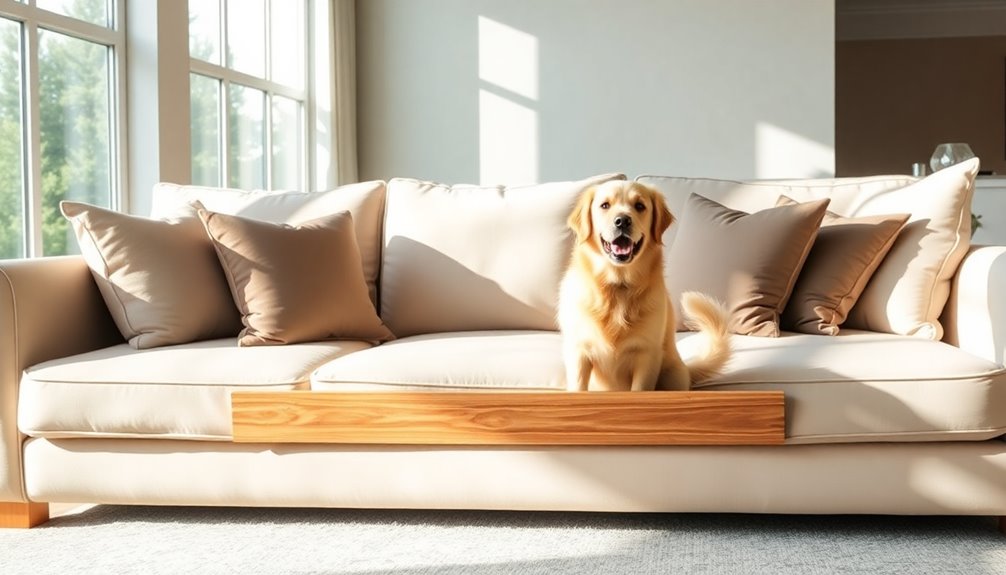
Sometimes, keeping your dog off the sofa can feel like a constant battle, but furniture barriers can make a significant difference. You can start by using products like the Couch Defender, which are easy to set up and remove in under 30 seconds. These barriers create a clear physical boundary that discourages your dog from jumping onto the furniture.
Environmental modifications also play a key role in pet-proofing your space. Placing cushions upright on the sofa can act as an additional barrier, while scat mats or aluminum foil on the couch surfaces provide an uncomfortable sensation, further deterring your dog.
Consider implementing baby gates to restrict access to rooms with furniture. This creates defined boundaries, making it easier for your dog to understand where they're allowed to go.
Lastly, regularly removing enticing items like blankets or pillows from the couch can help diminish its appeal. By combining these strategies, you’ll create an effective system of furniture barriers and environmental modifications that keeps your dog off the sofa while promoting better behavior. In addition to these strategies, utilizing natural bird repellent methods such as hanging shiny objects or using ultrasonic devices can further deter your dog from jumping on the couch. By consistently implementing these techniques, you can establish a clear boundary for your dog and create a comfortable, inviting space for them elsewhere in your home. This will ultimately lead to a happier and more harmonious living environment for both you and your furry friend.
Ongoing Training for Behavior Management
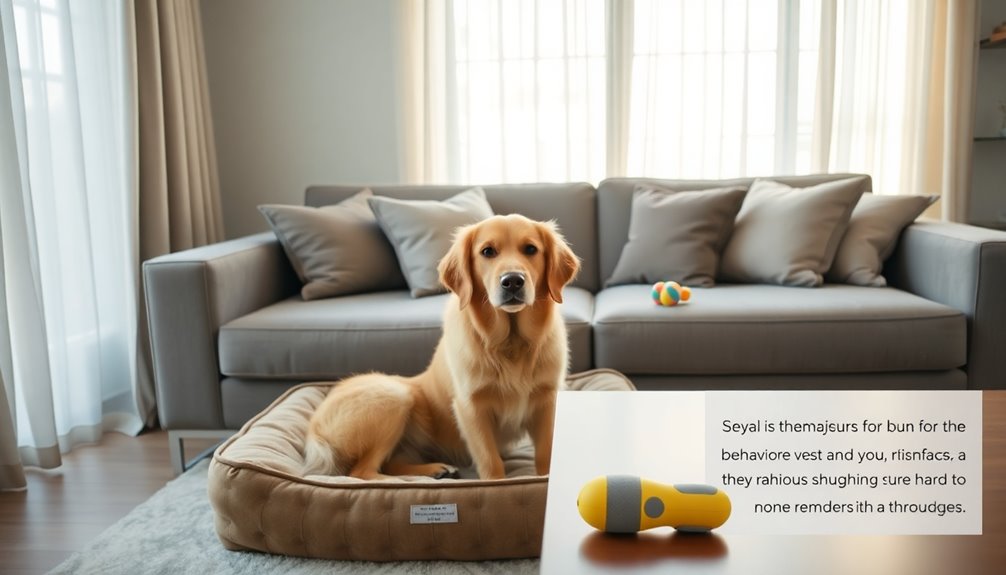
Training is essential for managing your dog's behavior and keeping them off the sofa. Consistent training sessions utilizing positive reinforcement techniques—like treats and praise—work wonders in teaching your dog to stay off the sofa and use designated resting areas instead. Regularly practicing commands such as "off" or "stay" reinforces boundaries and sets clear expectations for your dog regarding furniture access.
Incorporating clicker training can enhance behavior management by marking desired actions when your dog chooses their bed over the couch. Gradually increasing the time they spend in these designated spots helps solidify the habit. Engaging with your dog and spending time on the floor can also reduce their desire to jump on the couch, as it promotes bonding in their designated areas.
To ensure your dog clearly understands their boundaries, maintain a structured training regimen with all family members enforcing the same rules. This consistency prevents confusion about furniture access and reinforces your dog's understanding of acceptable behavior. By committing to ongoing training, you'll create an environment where your dog feels secure and knows they belong in their own space.
Conclusion
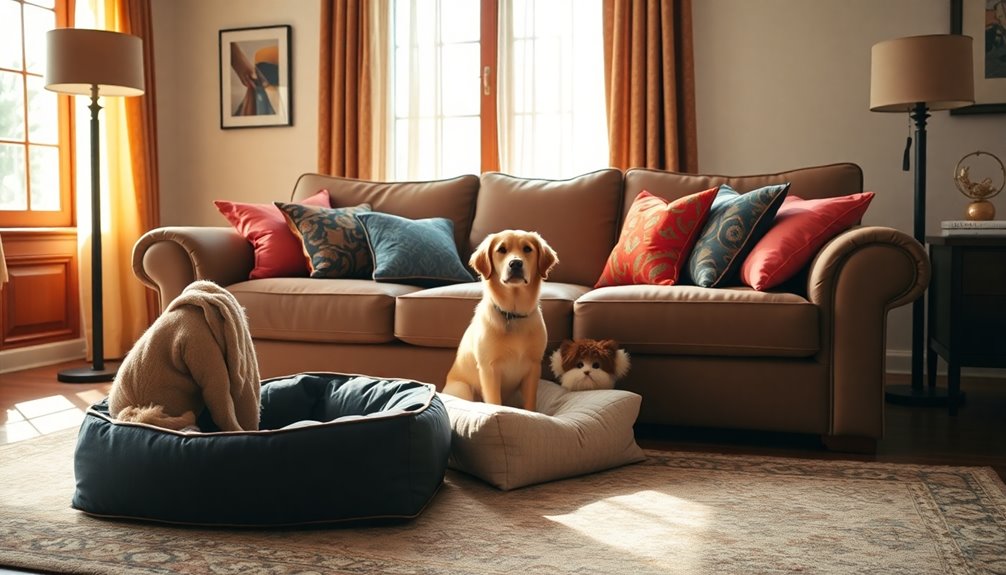
Successfully keeping your dog off the sofa requires commitment and consistency from everyone in your household. Start by establishing a strict no-couch policy from the moment you bring a puppy home. Early training helps prevent unwanted habits from forming, making it easier to keep your dog off the furniture. Use positive reinforcement techniques, rewarding your dog with treats and praise when they choose their designated bed or place instead of the sofa.
Create a comfortable and inviting space for your dog with appropriate bedding and toys to encourage them to relax away from the couch. This makes it more appealing for them to stay in their designated area. Consistency is key, so ensure all family members adhere to the same rules regarding furniture access. Confusion can arise if some allow the dog on the sofa while others don't.
Consider using physical barriers, like couch defenders or baby gates, to help reinforce your training efforts. By implementing these strategies and remaining steadfast in your approach, you can successfully keep your dog off the sofa, fostering a harmonious living environment for both you and your furry friend.
Frequently Asked Questions
What Can I Put on the Couch to Keep My Dog Off?
To keep your dog off the couch, you can try a few effective methods. First, place cushions or pillows upright as barriers. You might also consider a deterrent mat that emits a mild static correction. Another option is to use aluminum foil or double-sided tape, which many dogs dislike. Finally, using furniture covers can protect your couch and discourage your dog from jumping up while keeping them comfortable in their own space.
How to Get a Dog to Stay off the Couch?
To get your dog to stay off the couch, establish clear boundaries right from the start. Use positive reinforcement, rewarding them with treats or praise when they choose their own space. Consistently use commands like "off" or "down" to redirect them when they try to jump up. Make their designated area cozy with beds and toys, and regularly train to reinforce these rules, ensuring everyone in the household applies them consistently.
How Do I Stop My Dog From Jumping up on the Sofa?
To stop your dog from jumping up on the sofa, start by establishing clear boundaries. Use commands like "off" or "down" consistently whenever your dog tries to jump. Reinforce positive behavior with treats and praise when they stay in their designated area. You might also consider physical barriers, such as baby gates, to limit access when you can't supervise. Engaging with your dog on the floor will help them feel more comfortable there.
How to Make a Couch Dog Proof?
Making your couch dog-proof involves a few simple strategies. Start by using protective covers or slipcovers to shield against hair and scratches. You can set up physical barriers like baby gates or rearrange furniture to limit access. Consider applying deterrent mats or sprays that create an uninviting feel. Lastly, keep any enticing items, like blankets, out of reach to prevent your dog from being drawn to the couch in the first place.
